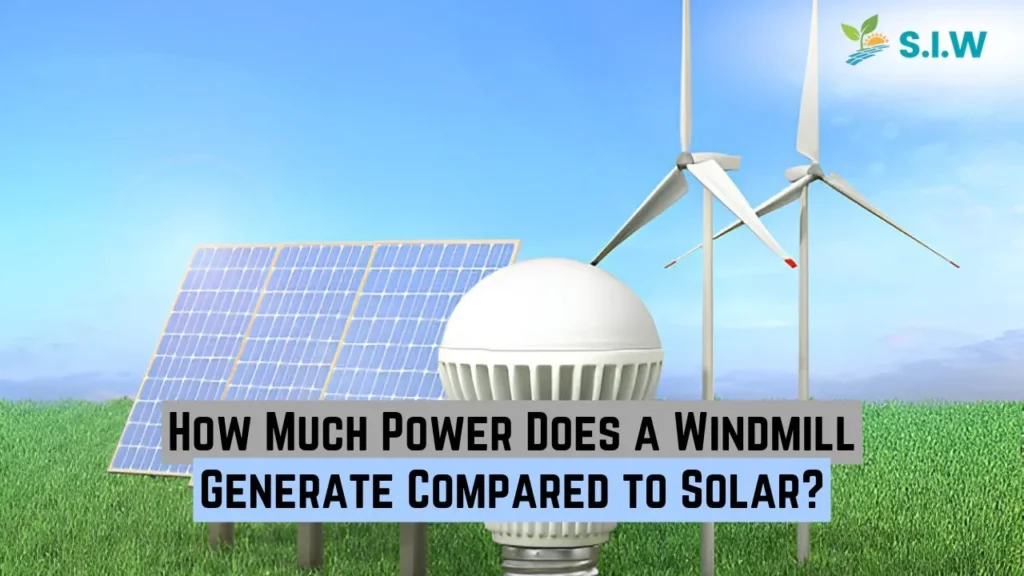In the quest for renewable energy solutions, both wind and solar power have emerged as dominant forces, each harnessing natural resources to produce electricity. Understanding the comparative power generation capabilities of windmills and solar panels is essential for homeowners, businesses, and policymakers aiming to make informed decisions about energy production and consumption.
Wind Power Generation: An Overview
Wind power relies on the kinetic energy of moving air to generate electricity. Windmills, also known as wind turbines, convert wind energy into electrical energy through a series of components, including blades, a rotor, a generator, and a tower.
Efficiency of Wind Turbines
The efficiency of wind turbines can vary based on several factors, including:
- Wind Speed: Turbines are designed to operate within specific wind speed ranges, typically between 9 to 50 mph. The amount of power generated increases significantly with wind speed, reaching maximum output at a designated cut-in speed (usually around 3 mph).
- Turbine Size: Larger turbines can capture more wind energy, leading to higher power generation. For example, a 2 MW turbine can produce approximately 6,000 to 12,000 MWh annually, depending on wind conditions.
- Location: The geographical location of a wind farm is crucial. Areas with consistent, high wind speeds (e.g., coastal regions or open plains) tend to yield more energy compared to locations with less favorable wind conditions.
Average Power Output
On average, a modern onshore wind turbine rated at 2.5 MW can generate about 6,000 to 8,000 MWh per year. In optimal wind conditions, wind farms can achieve capacity factors of 40% to 50%, meaning they produce energy at or near their maximum capacity for a substantial portion of the year.
Solar Power Generation: An Overview
Solar energy is harnessed using photovoltaic (PV) panels, which convert sunlight directly into electricity. The effectiveness of solar power generation depends on several key factors.
Efficiency of Solar Panels
The efficiency of solar panels is influenced by:
- Panel Technology: Monocrystalline panels tend to have the highest efficiency rates, typically between 15% and 22%. In contrast, polycrystalline panels offer efficiencies of around 13% to 16%.
- Sunlight Availability: The amount of sunlight a location receives directly impacts solar power generation. Areas closer to the equator or those with fewer cloudy days will produce more energy than regions with less sunlight.
- Installation Angle and Orientation: The angle at which solar panels are installed can affect energy output. Panels oriented towards the sun can capture more energy throughout the day.
Average Power Output
A typical residential solar panel system, consisting of around 20 panels with a total capacity of approximately 6 kW, can produce between 8,000 and 10,000 kWh annually in a sunny region. This equates to an average daily generation of 22 to 28 kWh, depending on weather conditions and seasonal variations.
Comparative Analysis: Wind vs. Solar Power Generation
Energy Generation Potential
When comparing the energy generation potential of wind and solar, several metrics can be considered:
- Capacity Factor:
- Wind: As mentioned, onshore wind turbines can achieve capacity factors of 40% to 50%. Offshore turbines can reach even higher capacity factors, sometimes exceeding 50% due to stronger and more consistent winds.
- Solar: Solar panels typically have capacity factors ranging from 15% to 25%, primarily due to intermittent sunlight and varying weather conditions.
- Annual Energy Output:
- A 2.5 MW wind turbine can produce approximately 6,000 to 8,000 MWh annually.
- A residential solar power system with a total capacity of 6 kW might produce around 8,000 to 10,000 kWh per year.
Land and Space Considerations
The land requirements for each energy source are significant when comparing wind and solar power.
- Wind Farms: Wind farms require substantial space to minimize the effects of turbine wake (the area of turbulence behind a turbine that can reduce efficiency for downstream turbines). A typical wind farm may require around 30 to 50 acres per MW of installed capacity. However, the land can often be used for agriculture or other purposes simultaneously.
- Solar Farms: Solar farms require approximately 5 to 10 acres per MW, depending on the type of installation (fixed tilt or tracking systems). Unlike wind farms, solar installations typically occupy the land entirely, making them less versatile in terms of simultaneous land use.
Economic Considerations
Economic viability plays a crucial role in the adoption of wind and solar energy.
- Installation Costs:
- Wind: The average cost of onshore wind installations ranges from $1,200 to $1,700 per kW, while offshore installations can exceed $6,000 per kW.
- Solar: The cost for residential solar panel systems averages around $2.50 to $3.50 per watt, making solar energy more accessible for homeowners.
- Maintenance Costs:
- Wind turbines generally require more maintenance due to moving parts, with annual costs averaging 1% to 2% of the initial investment.
- Solar panels have minimal maintenance requirements, primarily needing periodic cleaning and inspection, resulting in lower overall maintenance costs.
Environmental Impact
Both wind and solar energy sources are significantly cleaner than fossil fuels, but they come with their environmental impacts:
- Wind: Wind turbines can affect bird and bat populations, particularly if not strategically placed. Additionally, the visual impact of large wind farms can be a concern for local communities.
- Solar: The production of solar panels can involve harmful chemicals and significant water usage, but they do not produce emissions during operation. Additionally, end-of-life recycling and disposal of solar panels need to be managed carefully.
In The End
In conclusion, while both wind and solar energy have their advantages and challenges, the choice between them often depends on specific geographical, economic, and environmental contexts. Wind energy typically offers higher power generation potential in suitable locations, while solar energy provides a more straightforward and accessible solution for individual homeowners. Ultimately, a combination of both energy sources may provide the most effective approach to transitioning to a sustainable energy future, allowing communities to harness the benefits of each technology based on local resources and needs.








